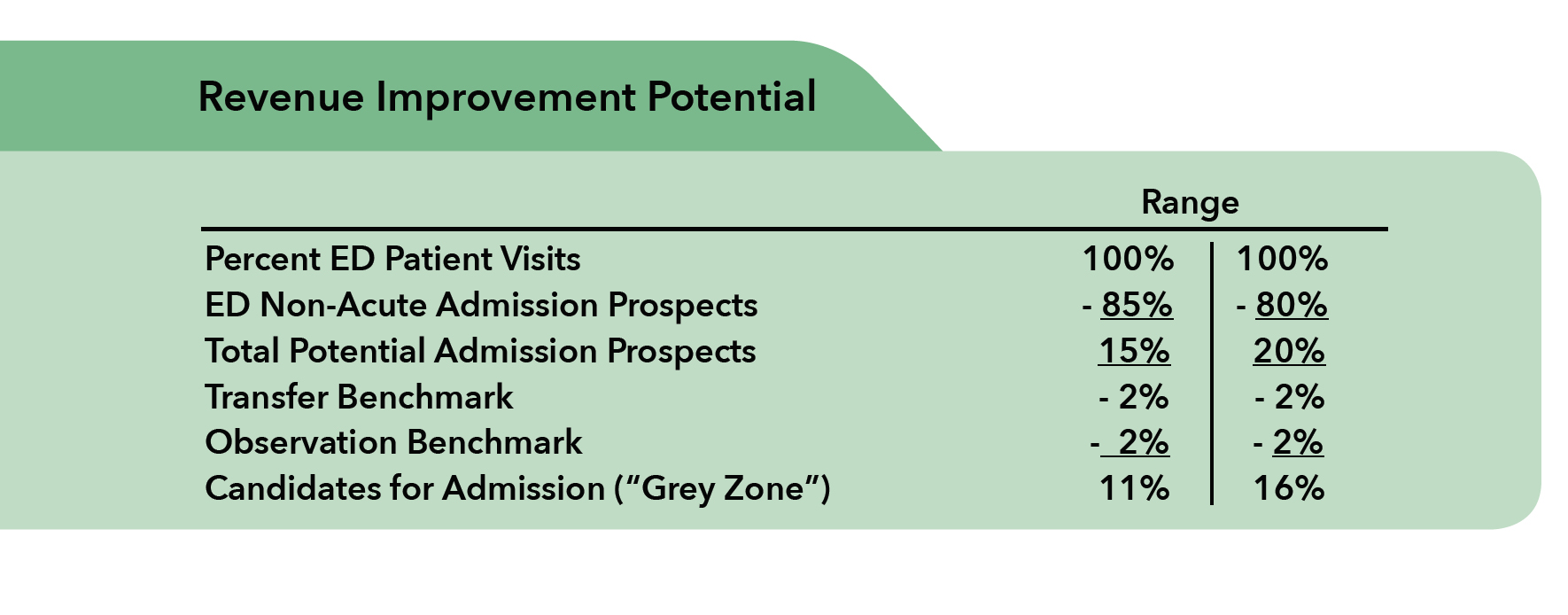Historically, most hospitals, large and small, have been organized around patient diagnoses, treatments, procedures, anatomy, diagnostic examination, acuity, and age. Clinical support services that did not fit came to be classified generally as “ancillary” services.
These organizational structures derive primarily from large teaching hospitals where these structures work well for teaching specialized medicine. Thus, it seems natural to organize and manage Emergency Medicine (EM) and inpatient medicine, or Hospital Medicine (HM), in the small community hospital (SCH) as two separate services, two separate specialties, and two separate hospital departments.
But this structure is ineffective for managing the BUSINESS of EM and HM. Why?
Financial impact
To understand the financial impact, let’s look at what could be expected. Approximately 80% to 85% of all ED patients do not qualify as inpatient admission candidates. Observation patients should not exceed 2% and transfers should not exceed 2%. 
This leaves a “grey zone” of about 11% to 16% that are potential candidates for admission. National acute admission rates through the ED are 13%. As a concession for SCHs (and low expectations), some people suggest that 8% is a more reasonable target, and many SCHs transfer more than 2% and classify more than 2% of their patients as observation.
For a SCH that has 8,000 ED patient visits per year, this “grey zone” represents the potential to admit 880 (8,000 x 11%) to 1,280 (8,000 x 16%) patients per year. At a modest $5,000 in net revenue per discharge, the total revenue potential is $4,400,000 and $6,400,000 respectively. The difference between 880 to 1,280, and your actual acute admissions, represents your revenue growth potential. If the sum of your admissions is 600 per year, your potential net revenue is approximately $1,400,000 to $3,400,000.
Operational and financial insight into these numbers
Under the traditional “silo” organizational and specialty structure, the EM physician identifies and refers to the attending physician what he believes is an admission prospect according to his EM assessment and risk threshold. Even where the EM physician has attending experience from the past, he still makes his medical decisions from the “silo” perspective. The attending (or HM) physician usually doesn’t know this patient well and therefore must perform an assessment of medical necessity and “can I take care of this particular patient?” This assessment takes time and involves risk.

What does this have to do with financial success? Everything!
The EM’s willingness to refer to the attending is his perception of the risk threshold and clinical capability of the HM physician. This perception influences his willingness to even refer current and future admissions. Likewise, the willingness of the HM physician, who is the only physician in the hospital on any day, depends on his risk threshold and clinical capability to take care of the patient locally.
The bottom line is that on any given day, the SCH’s capacity to keep patients local is limited by the lowest clinical capability and risk threshold of all EM or HM physicians.

This is true because on any given day, the “weakest link” physician will be working. This does not mean any such physician is a bad physician. It means he may not be well suited to be the sole EM or HM physician working at a SCH. In other words, it is essential that EM and HM physicians that work at a SCH must have the highest clinical capabilities and take appropriate risk, and possess a team-oriented mentality suited to full and seamless integration.
In most cases, the EM and HM physicians are paid, regardless of admitting and attending any patients. There is also a real barrier of “human nature” and “personal and organizational motivation”. Therefore, insight into EM and HM candidate selection is essential.
Now that we have insight into how these admissions decisions are made, what insight do we need to solve the problem?
The solution is a practice mode that is designed to effectively overcome these barriers. The design elements of this model include:
- An integrated EM and HM service.
- A single Medical Director responsible and accountable for both services.
- An agreement among the physician regarding the highest scope (and appropriate risk) of medical conditions that can be managed and treated locally based on the SCH’s available services.
- EM and HM providers each of which have the same clinical capability and risk threshold (and know when they can pass the baton without stopping to ask, “Who is working tomorrow?”).
- Providers who are both challenged and motivated by their authority and responsibility to make the SCH financially viable.
Lastly, this model needs leadership and management that is committed and accountable for success, supported by hospital leadership, and a medical staff that is aligned. This is not a staffing or coverage solution, it is a revenue solution that takes bold vision and implementation.
Jim Burnette is the Founder and CEO of HospitalMD. Jim has worked in healthcare for more than 20 years. His mission is to strengthen Small Community Hospitals across the nation and help them thrive in today’s rapidly changing healthcare climate. Jim is a graduate of Georgia Tech and resides in Peachtree City, a small community right outside Atlanta, GA. Contact Jim at insight@hospitalmd.com,
© 2017 HospitalMD. All rights reserved.
